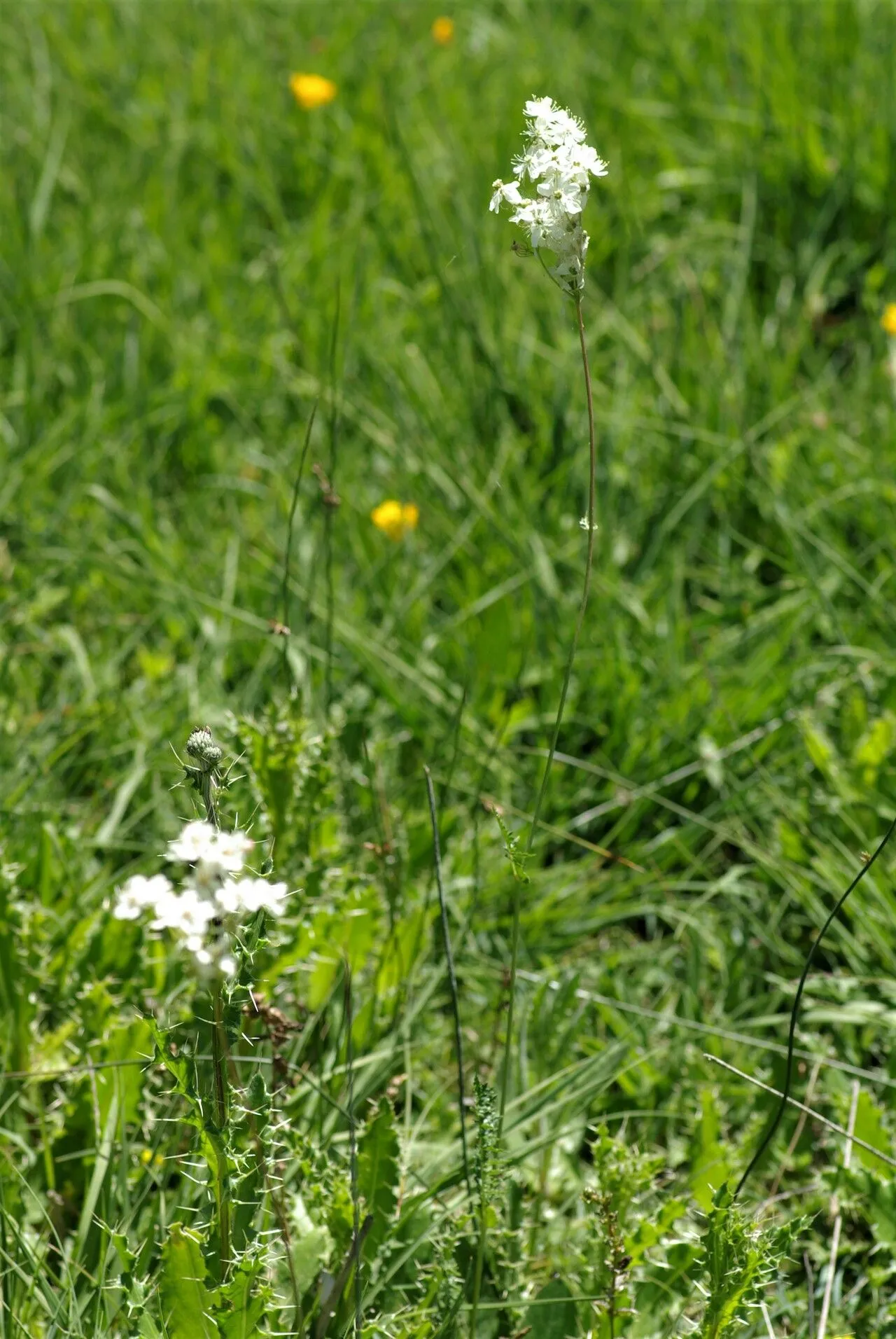
Author: Moench
Bibliography: Methodus: 663 (1794)
Year: 1794
Status: accepted
Rank: species
Genus: Filipendula
Vegetable: False
Observations: Azores, NW. Africa, Europe to S. Siberia and Iran
Dropwort, known scientifically as Filipendula vulgaris, is a noteworthy member of the family Rosaceae, first described in the Methodus in 1794 by the botanist Moench. This perennial herbaceous plant is distinguished by its affinity for well-drained, calcareous soils, and is commonly found in a wide geographical range extending from the Azores and Northwestern Africa through Europe to southern Siberia and Iran.
The plant is easily recognizable by its delicate, feathery leaves and clusters of small, creamy-white flowers that bloom in the late spring and early summer. Dropwort’s floral structure is characterized by its dense cymes of blossoms, each containing numerous stamens that lend a characteristic fluffy appearance. The flowers are not only aesthetically pleasing but also emit a sweet fragrance that attracts a variety of pollinators, playing a crucial role in its reproductive cycle.
Dropwort typically grows to a height of 30-60 centimeters and can be found thriving in meadows, grasslands, and other open habitats. The plant’s roots have a tuberous nature, aiding its survival and making it well-suited to nutrient-poor environments. Its ability to flourish in such challenging conditions is a testament to its adaptability and resilience.
In addition to its ecological significance, Filipendula vulgaris has been utilized in traditional medicinal practices. It is reputed for its potential applications in herbal remedies, particularly for its anti-inflammatory and diuretic properties. Historical records suggest its use in treating various ailments, although modern scientific validation of these uses is limited.
Overall, Filipendula vulgaris embodies both botanical charm and practical utility. Its widespread prevalence across diverse regions underscores its ecological versatility, while its historical use in folk medicine highlights the enduring human connection to this remarkable plant. Through its elegant floral displays and resilient growth habits, Dropwort continues to capture the interest and admiration of botanists, gardeners, and nature enthusiasts alike.
Eng: dropwort, common queen-of-the-meadow
Deu: kleines mädesüß, knollige spierstaude
Dan: knoldet mjødurt
Swe: brudbröd, sikoangervo
Fra: filipendule, filipendule vulgaire
Nob: knollmjødurt
Nno: knollmjødurt
Nld: knolspirea
Fin: sikoangervo
Cym: crogedyf, y grogedau
En: Dropwort, Common queen-of-the-meadow
Hy: Փրփրուկ տափաստանային
Az: Adi quşqonmaz
Ba: Аҡбаш
Be: Вятроўнік звычайны
Bg: Ливадно орехче
Ca: Filipèndila, Filipèndula vulgar
Zh: 土庄绣线菊
Cs: Tužebník obecný
Da: Knoldet Mjødurt
Nl: Knolspirea
Et: Angerpist
Fi: Sikoangervo
Fr: Filipendule, Filipendule commune, Spirée filipendule, Filipendule vulgaire
De: Knollige Spierstaude, Kleines Mädesüß, Knolliges Mädesüß, Steppen-Spierstaude
Hu: Koloncos legyezőfű
Ga: Lus braonach
It: Olmaria peperina
Lv: Lielziedu vīgrieze
Lt: Pievinė vingiorykštė
Mk: Обичен тажник
No: Knollmjødurt
Nb: Knollmjødurt
Nn: Knollmjødurt
Fa: اسپیره
Pl: Wiązówka bulwkowa
Ro: Aglică
Ru: Таволга обыкновенная
Sk: Túžobník obyčajný
Es: Filipéndula, Hierba del pobre
Sv: Brudbröd, Sikoangervo
Uk: Гадючник шестипелюстковий
Cy: Y Grogedau, Crogedyf
Taken May 31, 2020 by Gerrit Busser (cc-by-sa)
Taken Jul 30, 2018 by Marcos Rivas Campoamor (cc-by-sa)
Taken Jul 30, 2018 by Marcos Rivas Campoamor (cc-by-sa)
Taken May 26, 2017 by Tela Botanica − Bozena PLUCIENNICKA (cc-by-sa)
Taken May 22, 2017 by Jean-René Girardeau (cc-by-sa)
Taken Jun 12, 2020 by Irmgard Groß (cc-by-sa)
Taken Jun 1, 2014 by Alain Bigou (cc-by-sa)
Taken Oct 14, 2021 by Jacques Zuber (cc-by-sa)
Taken Jul 3, 2017 by Miguel A. C. (cc-by-sa)
Taken Jun 12, 2020 by Irmgard Groß (cc-by-sa)
Taken Oct 14, 2021 by Jacques Zuber (cc-by-sa)
Taken Dec 5, 2022 by Peter Schweiger (cc-by-sa)
Taken May 31, 2020 by Gerrit Busser (cc-by-sa)
Taken Jul 30, 2018 by Marcos Rivas Campoamor (cc-by-sa)
Taken Jul 30, 2018 by Marcos Rivas Campoamor (cc-by-sa)
Taken Apr 20, 2017 by Yoan MARTIN (cc-by-sa)
Taken Apr 20, 2017 by Yoan MARTIN (cc-by-sa)
Taken Apr 20, 2017 by Yoan MARTIN (cc-by-sa)
Taken Nov 2, 2021 by Douglas Scofield (cc-by-sa)
Taken Oct 14, 2021 by Jacques Zuber (cc-by-sa)
Taken Jan 1, 1800 by Tela Botanica − Thierry Pernot (cc-by-sa)
Taken Apr 20, 2017 by Yoan MARTIN (cc-by-sa)
Taken Apr 20, 2017 by Yoan MARTIN (cc-by-sa)
Taken Apr 19, 2017 by Yoan MARTIN (cc-by-sa)
Taken Feb 20, 2021 by Shiva Moqan (cc-by-sa)
Taken Jul 15, 2013 by Photoflora – Benoit BOCK (©)
Taken Jan 1, 1970 by Photoflora – L’Abbé COSTE (©)
Taken Jun 4, 2013 by Tela Botanica − Liliane Roubaudi (cc-by-sa)
Taken Jun 4, 2013 by Tela Botanica − Liliane Roubaudi (cc-by-sa)
Taken Jun 3, 2013 by Tela Botanica − Liliane Roubaudi (cc-by-sa)
© copyright of the Board of Trustees of the Royal Botanic Gardens, Kew.
© copyright of the Board of Trustees of the Royal Botanic Gardens, Kew.
© copyright of the Board of Trustees of the Royal Botanic Gardens, Kew.
Growth habit: Forb/herb
Ph maximum: 8.0
Ph minimum: 7.5
Light: 7
Atmospheric humidity: 5
Soil nutriments: 3
Family: Myrtaceae Author: (F.Muell.) K.D.Hill & L.A.S.Johnson Bibliography: Telopea 6: 402 (1995) Year: 1995 Status:…
Family: Rubiaceae Author: Pierre ex A.Froehner Bibliography: Notizbl. Bot. Gart. Berlin-Dahlem 1: 237 (1897) Year:…
Family: Sapindaceae Author: Koidz. Bibliography: J. Coll. Sci. Imp. Univ. Tokyo 32(1): 38 (1911) Year:…
Family: Asteraceae Author: A.Gray Bibliography: Pacif. Railr. Rep.: 107 (1857) Year: 1857 Status: accepted Rank:…
Family: Fabaceae Author: Medik. Bibliography: Vorles. Churpfälz. Phys.-Ökon. Ges. 2: 398 (1787) Year: 1787 Status:…
Family: Aspleniaceae Author: (Cav.) Alston Bibliography: Bull. Misc. Inform. Kew 1932: 309 (1932) Year: 1932…